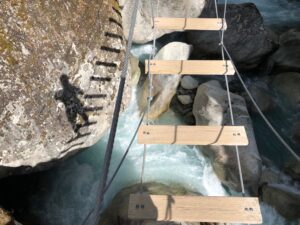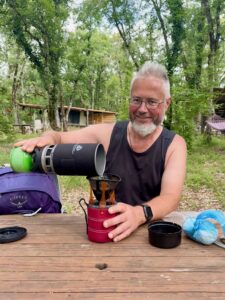
My projects usually start with a childlike curiosity to “what would happen if… ?” What would happen if I light up a glass sphere containing a 3D model of the human brain with a red laser? What would happen if I make a beautiful, classic brass morse key and use it to play something silly like ‘Flappy Bird’?
From that initial wonder my projects grow. Initially just in my mind, but soon in a 3D design application or directly under my hands. I like things that move. Things that spin, turn, make noise and show beautiful patterns. I’m always looking for ways to surprise, to use something in a new way. Using the brass morse key to play Flappy Bird results in noise that sounds very much like real morse code, at least to the untrained ear.
As an artist I’m mostly self-taught. Born in 1970 in the Dutch city of Schiedam, I grew up with a broad interest in mechanics, electronics, history and the way that humans interact with each other. When I was in high school, the Commodore 64 became the first affordable ‘home computer.’ It taught me how to write code. After a brief episode studying mechanical engineering at the Delft University of Technology, terminated due to a lack of interest in maths, I switched radically to study cognitive psychology at the University of Utrecht. In 1994 I graduated on a decision support system helping clinical psychologists to determine the right kind of therapy for their depressed clients.

In 1995 I started as a psychologist at a small company in Gouda. I designed visual manuals and other course materials. In 1999 I came up with a smart way to quickly and efficiently create simulations of any Windows program. This became a great success. In 2000 our company was taken over by the American Siebel Software, at the time a big name in “Customer Relations Management”. I stayed here with a small team working on ‘SimBuilder’, my brainchild. Here I saw courses developed with SimBuilder in Russian, Japanese, Thai, Spanish, French, German and many variants of English. In 2006 Siebel was taken over by Oracle, the database giant.
My love for electronics and mechanical engineering revived in 2015 with the construction of the ‘Nautilus’, a Jules Verne-like ‘photo booth’ with which guests at my sister’s wedding could take group photos. By combining old technology – like 1950s Nixie tubes – with modern microcontrollers, the Nautilus amazed people with smoke, lights and bubbles. And of course, great photos. Since that wedding, it has been used at many other parties and events.
Combining manual skills like lathe turning and metal milling with modern technologies like 3D modeling, microcontrollers and custom-designed electronics boards, I have improved my skills over the years to work ever more precisely. My 2024 ‘Tehuti Brain Scanner’ got a lot of interest at a conference of neuroscientists and neuroscience students at the University of Nijmegen.
I prefer to work with classic materials like brass, wood and glass, blending them with modern electronics like Arduino microcontrollers and Raspberry Pi mini computers.